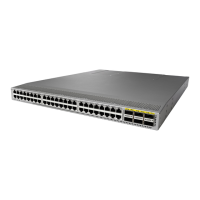Send document comments to nexus3k-docfeedback@cisco.com
3-40
Cisco Nexus 3000 Series NX-OS Unicast Routing Configuration Guide, NX-OS Release 5.0(3)U1(1)
Chapter 3 Configuring OSPFv2
Configuring Advanced OSPFv2
4. vrf vrf-name
5. maximum-paths paths
6. interface interface-type slot/port
7. no switchport
8. vrf member vrf-name
9. ip-address ip-prefix/length
10. ip router ospf instance-tag area area-id
11. (Optional) copy running-config startup-config
DETAILED STEPS
Command Purpose
Step 1
configure terminal
Example:
switch# configure terminal
switch(config)#
Enters configuration mode.
Step 2
vrf context
vrf-name
Example:
switch(config)# vrf context
RemoteOfficeVRF
switch(config-vrf)#
Creates a new VRF and enters VRF configuration
mode.
Step 3
router ospf
instance-tag
Example:
switch(config-vrf)# router ospf 201
switch(config-router)#
Creates a new OSPFv2 instance with the configured
instance tag.
Step 4
vrf
vrf-name
Example:
switch(config-router)# vrf
RemoteOfficeVRF
switch(config-router-vrf)#
Enters VRF configuration mode.
Step 5
maximum-paths
paths
Example:
switch(config-router-vrf)# maximum-paths
4
(Optional) Configures the maximum number of equal
OSPFv2 paths to a destination in the route table for this
VRF. Used for load balancing.
Step 6
interface
interface-type slot/port
Example:
switch(config-router-vrf)# interface
ethernet 1/2
switch(config-if)#
Enters interface configuration mode.
Step 7
no switchport
Example:
switch(config-if)# no switchport
Configures the interface as a Layer 3 routed interface.

